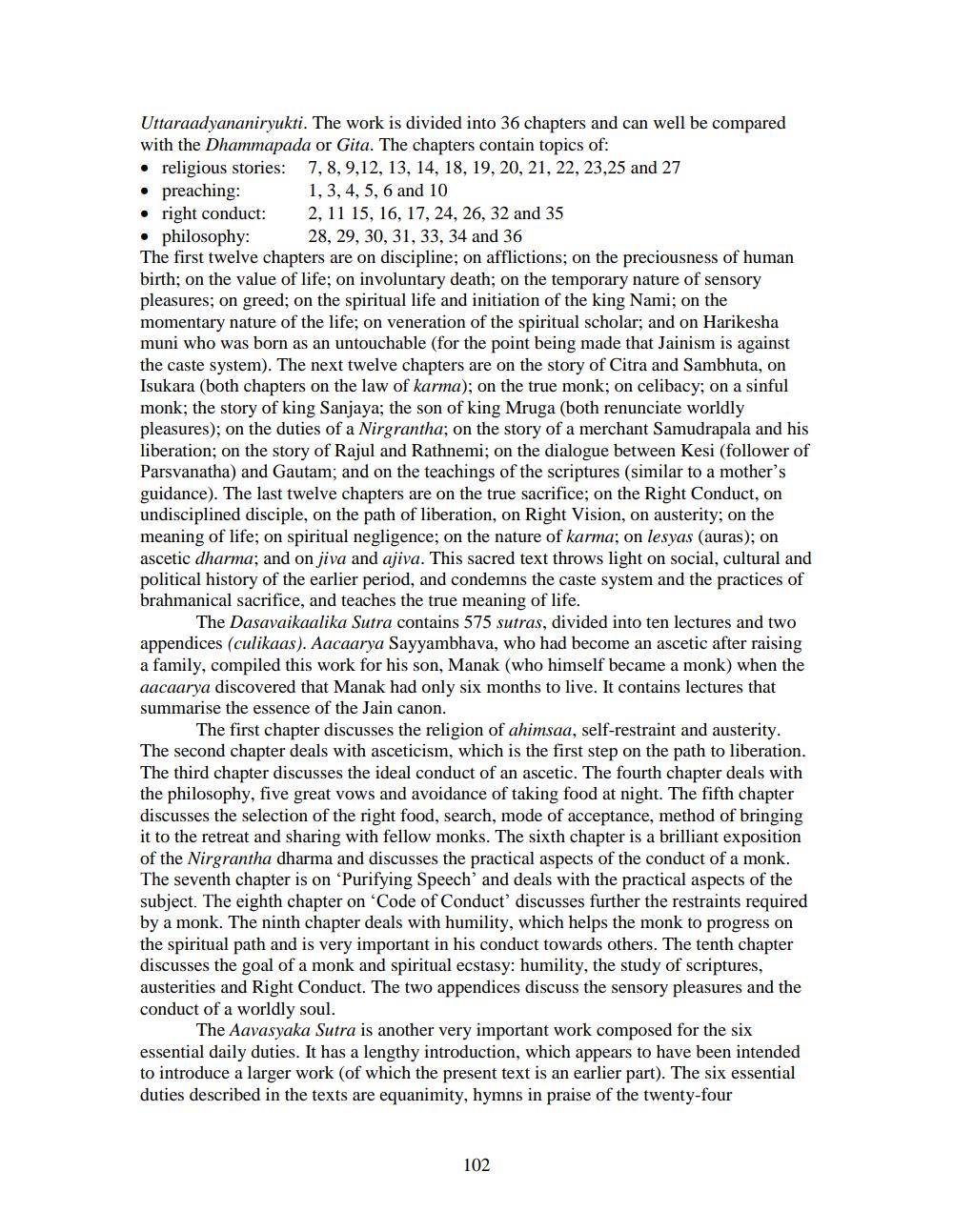________________
Uttaraadyananiryukti. The work is divided into 36 chapters and can well be compared with the Dhammapada or Gita. The chapters contain topics of: • religious stories: 7,8,9,12, 13, 14, 18, 19, 20, 21, 22, 23,25 and 27 • preaching: 1, 3, 4, 5, 6 and 10 • right conduct: 2, 11 15, 16, 17, 24, 26, 32 and 35 • philosophy: 28, 29, 30, 31, 33, 34 and 36 The first twelve chapters are on discipline; on afflictions; on the preciousness of human birth; on the value of life; on involuntary death; on the temporary nature of sensory pleasures; on greed, on the spiritual life and initiation of the king Nami; on the momentary nature of the life; on veneration of the spiritual scholar; and on Harikesha muni who was born as an untouchable (for the point being made that Jainism is against the caste system). The next twelve chapters are on the story of Citra and Sambhuta, on Isukara (both chapters on the law of karma); on the true monk; on celibacy; on a sinful monk; the story of king Sanjaya; the son of king Mruga (both renunciate worldly pleasures); on the duties of a Nirgrantha; on the story of a merchant Samudrapala and his liberation, on the story of Rajul and Rathnemi, on the dialogue between Kesi (follower of Parsvanatha) and Gautam, and on the teachings of the scriptures (similar to a mother's guidance). The last twelve chapters are on the true sacrifice; on the Right Conduct, on undisciplined disciple, on the path of liberation, on Right Vision, on austerity; on the meaning of life; on spiritual negligence; on the nature of karma; on lesyas (auras); on ascetic dharma; and on jiva and ajiva. This sacred text throws light on social, cultural and political history of the earlier period, and condemns the caste system and the practices of brahmanical sacrifice, and teaches the true meaning of life.
The Dasavaikaalika Sutra contains 575 sutras, divided into ten lectures and two appendices (culikaas). Aacaarya Sayyambhava, who had become an ascetic after raising a family, compiled this work for his son, Manak (who himself became a monk) when the aacaarya discovered that Manak had only six months to live. It contains lectures that summarise the essence of the Jain canon.
The first chapter discusses the religion of ahimsaa, self-restraint and austerity. The second chapter deals with asceticism, which is the first step on the path to liberation. The third chapter discusses the ideal conduct of an ascetic. The fourth chapter deals with the philosophy, five great vows and avoidance of taking food at night. The fifth chapter discusses the selection of the right food, search, mode of acceptance, method of bringing it to the retreat and sharing with fellow monks. The sixth chapter is a brilliant exposition of the Nirgrantha dharma and discusses the practical aspects of the conduct of a monk. The seventh chapter is on 'Purifying Speech' and deals with the practical aspects of the subject. The eighth chapter on 'Code of Conduct' discusses further the restraints required by a monk. The ninth chapter deals with humility, which helps the monk to progress on the spiritual path and is very important in his conduct towards others. The tenth chapter discusses the goal of a monk and spiritual ecstasy: humility, the study of scriptures, austerities and Right Conduct. The two appendices discuss the sensory pleasures and the conduct of a worldly soul.
The Aavasyaka Sutra is another very important work composed for the six essential daily duties. It has a lengthy introduction, which appears to have been intended to introduce a larger work (of which the present text is an earlier part). The six essential duties described in the texts are equanimity, hymns in praise of the twenty-four
102




